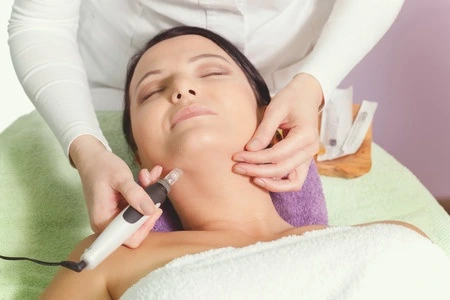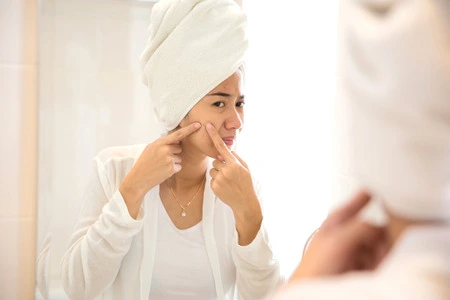Acne scars can scar you for life, and when you start to develop it, there is little you can do to stop it. Unfortunately, lotions and creams can only do so much, and people who develop acne scars often have to spend the rest of their life with the obvious signs of scarring on their face.
Thankfully, Fraxel laser treatment is here to burn those scars away. With just a few sessions of Fraxel laser tech, even the worst cases of acne scars can be healed.
What are Acne Scars?
Acne scarring is the most common skin problem that people suffer from, followed only by conditions like skin hyperpigmentation and melasma. The prevalence of acne scarring is because we all suffer from acne during adolescence and early adult years, which can sometimes leave behind acne scars.
But why exactly do some people suffer from acne scars while others don’t? Acne scars are products of inflamed lesions, which occurs when the pore in the skin becomes swollen with bacterial, dead skin cells, and/or excess oil.
The swelling leads to a rupture within the skin – if near the surface, the rupture tends to heal quickly, but if the rupture is deeper within the skin, the healthy skin tissue around it becomes compromised and destroyed.
Acne scars form to repair the damaged skin tissue. These scars are made of newly produced collagen fibers, and while it helps the skin return to a healthy state, it never has the same appearance as unscarred skin. This new collagen ends up filling out the texture of the scar on the face, although results never look as brand new as you might like.
3 Types of Acne Scars
There are three common types of acne scars that can develop as the body attempts to heal the skin from acne ruptures. These types are:
- Hypertrophic scarring: This type occurs when the body produces more collagen than necessary, leading to excess accumulated tissue on the surface of the skin, giving it a raised appearance. This is also known as keloid scarring.
- Atrophic scarring: This type occurs when not enough tissue is available to heal the skin properly. This happens when the skin cannot regenerate sufficient tissue, often when too much tissue is needed after cases of severe acne. There are three types of atrophic scarring:
- Rolling scars: Generally found on the cheeks, rolling scars have no clear edges
- Boxcar scars: Similar in appearance to chickenpox scars, boxcar cars have clear borders with flat bottoms
- Ice pick scars: Similar in appearance to deep sores, ice pick scars are generally narrow and small
- Post-inflammatory hyperpigmentation: Post-inflammatory hyperpigmentation is actually not a scar at all, although it is often misidentified as a scar. It is rather a temporary skin discoloration that fades over time.
How to Prevent Acne Scars
While scarring isn’t completely preventable, there are some tips you can follow to minimize scar development during severe cases of acne:
1) Treat your acne immediately. If you want to prevent yourself from having a lifetime of acne scars, it is crucial that you treat any severe acne immediately. If your acne doesn’t seem to respond to OTC acne treatments, consult your doctor about more serious steps to acne treatment.
2) Avoid messing with your pimples. While it might seem to make sense to pop your pimples to make them go away, this actually worsens the condition and health of your skin over time. By popping or squeezing your pimples, you force the debris deeper into your skin, leading to more infection within your skin. Let your pimples go away on their own.
3) Avoid messing with your scabs. If your pimples are gone and you are now left with scabs, ignore all temptations to pick at the scabs. The skin needs the scab to protect the wound while it is healing; picking it off only extends the healing process, thus increasing the probability of scar development.
4) Calm any skin inflammation. The more inflamed and swollen your blemishes are, the greater the chance they lead to acne scars. Do whatever you can to avoid irritating your skin, such as scrubbing it or using strong chemical skincare products.
5) See a dermatologist if you are prone to scarring. If you have a history of developing scars, you might want to visit a dermatologist at the first sign of acne, and see what can be done to help right away.
Treating Acne Scars: Fraxel Laser
It can feel impossible trying to treat acne scars, with countless creams and lotions on the market that don’t seem to have any effect. Thankfully, individuals who are serious about treating and removing their acne scarring can now consider laser treatment to get rid of their acne scarring treatment, with Fraxel Lasers.
Fraxel treatment uses fractional laser technology, allowing the doctor to treat a part of the skin at any given time, while leaving the rest of it intact and untreated. This allows for a laser-focused treatment that encourages quick collagen regeneration.
Fraxel is known as a non-ablative laser, which is popular for its scar treatment as well as for fading the hyperpigmentation also caused by acne breakouts. Patients who undergo Fraxel treatment can also expect to have any sun damage and other hyperpigmentation issues to be treated. All skin tones can be treated by Fraxel lasers, making it a top solution for anyone suffering from acne scars.
Everything You Need to Know About Fraxel Lasers
What do Fraxel Lasers treat?
Fraxel lasers are best at treating acne scars with much texture, as the laser breaks into the skin to break up the scar tissue leading to the texture issues on the skin in a way that lotions or creams can’t do.
What are the types of Fraxel lasers?
The most common Fraxel device is the Fraxel dual laser scar treatment acne device, which has two different lasers. The Fraxel Restore is non-ablative, meaning it is specialized for cases without any open wounds on the skin, while the Fraxel Repair is more powerful and is specific for severe cases with its ablative functionality.
Does Fraxel laser remove acne scars? How does it work?
Yes, Fraxel treatments do remove face acne as well as get rid of sun damage and other skin issues. Fraxel lasers work with targeted destruction. The laser’s energy destroys small parts of the scarred skin, leading to new collagen growth to replace the damaged skin cells.
This acne scar treatment of Fraxel laser acne scars is a great way to produce natural results, as it utilizes the body’s natural healing processes. There is no need for any non-natural treatments involved.
How do I take care of my skin after Fraxel laser treatments?
It is important to keep your skin protected, so use sun block whenever you go out. The skin must also be kept clear, so avoid any harsh chemical face products for at least a week after your treatments. Results are best if you moisturize and gently cleanse your face at least twice a day. And of course, for ideal results, avoid any kind of picking or peeling at your skin.
Can I wear makeup after Fraxel?
It is best to avoid putting any products on your face for up to a week after your treatments. If you need to place something on your face, make sure to deeply but gently moisturize and cleanse your face afterwards.
How long do laser treatments take to heal? How long do results last?
It can take up to a week for your skin to heal after the Fraxel acne scars treatment. Results last permanently, as the body’s natural healing processes are used to repair the skin.
Get Your Laser Treatments with Ethos Spa, New Jersey’s Premier Spot for All Skin and Laser Solutions
Have you been suffering from acne scarring all your life, and are you finally fed up of living with it? Ethos Aesthetics + Wellness, has helped countless patients just like you with our state-of-the-art laser technology.
Call us today or book an appointment through our website to learn more about how we can help your acne scars go away!
Learn more: Fraxel Laser VS Microneedling







